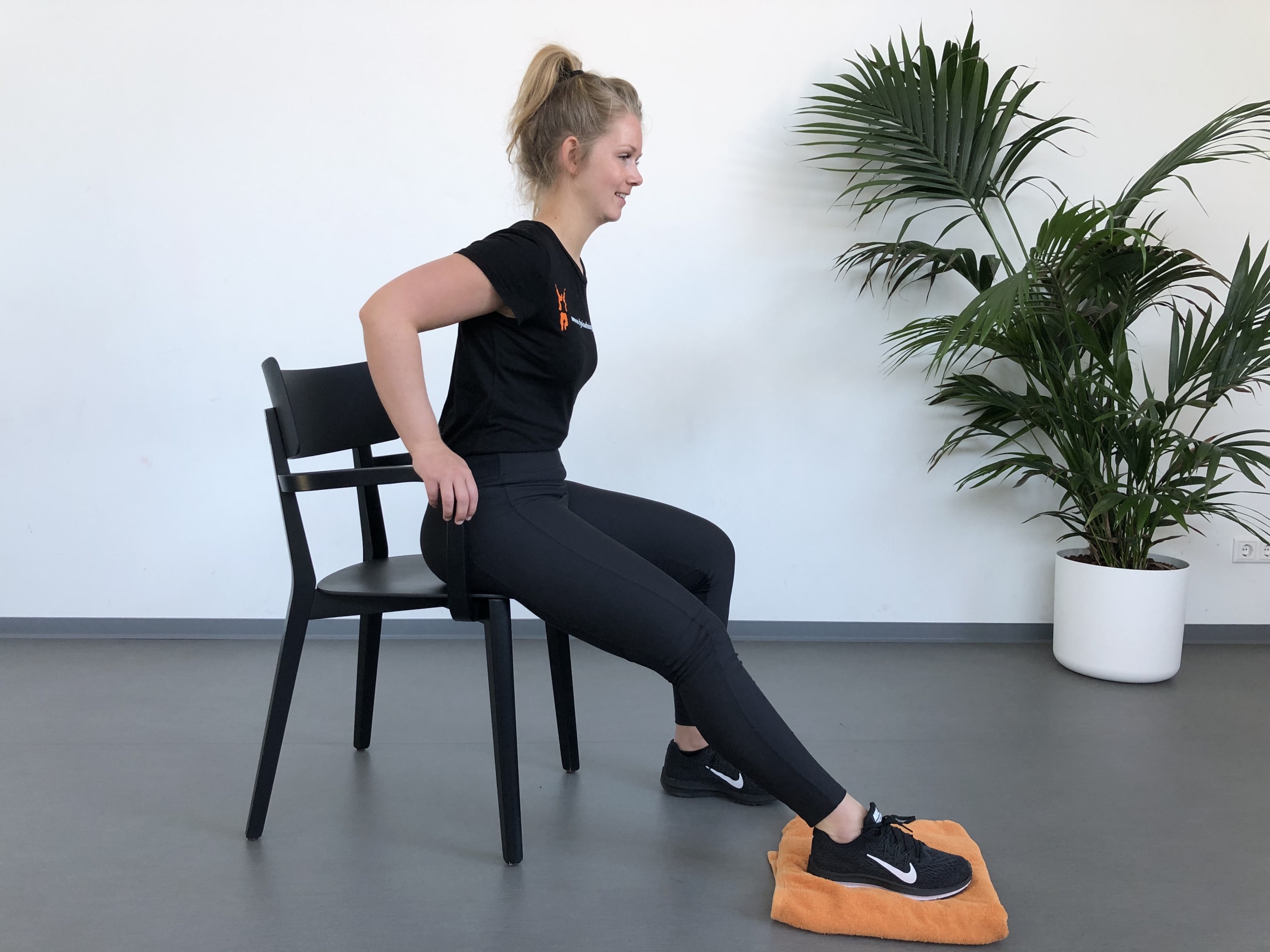
Severe ankle pain
Pain in the ankle is very common. If you experience many complaints (high reactivity), it is important to do a lot of movement exercises. You will find these below.
1. Knee slides in zit
Kom op de stoel zitten. Plaats de voet van het aangedane been op de handdoek. Schuif de handdoek zo ver mogelijk naar voren met de hak op de grond, schuif vervolgens de voet zo ver mogelijk naar achteren met de hak op de handdoek.
2. Mobilisatie circulaties (enkel)
Neem plaats op een stoel, strek uw been uit en maak cirkels vanuit het enkelgewricht.
3. Mobilisatie dorsaalflexie (enkel)
Zet uw handen tegen bijvoorbeeld de tafel en plaats uw aangedane been voor het niet aangedane benen en breng uw lichaam voorwaarts. Let op dat de hak van het aangedane been op de grond blijft staan.
4. Mobilisatie dorsaalflexie (enkel)
Ga op de grond zitten en plaats uw rug tegen de muur. Doe het stiek om uw voeten en trek het stiek naar u toe.
5. Mobilisatie dorsaalflexie (enkel)
Plaats de voeten op heupbreedte en neem met de handen steun tegen een muur. Zorg dat de hakken op de grond blijven staan en breng de knieën naar voren.
6. Mobilisatie dorsaalflexie (enkel)
Plaats de aangedane voet op een handdoek en neem steun met de handen tegen de muur. Breng vervolgens uw romp naar voren.
7. Actieve calf raise
Pak een stevige stoel, ga erop zitten en zorg voor een actieve houding waarbij de rug los is van de leuning. Plaats de voeten op ongeveer heupbreedte, kruis de armen voor de borst, breng de hakken zover mogelijk van de grond en laat ze vervolgens tot net boven de grond weer zakken.
Plyo box
Hard. Compact. Qualitatively.

Resistance band
Hard. Compact. Qualitatively.

The meaning of severe ankle sprain
Ankle injuries are common and range from mild to severe. Sometimes it only hurts a little while other injuries make it impossible to bear weight on the ankle. If the ankle pain is severe it is known as a highly reactive ankle. The healing process causes various changes at the cellular level around the ankle. This often sensitizes the area, causing pain.
The causes of severe ankle sprain
Ankle injuries can be caused by overuse (for instance due to long walks) or by spraining your ankle (in-/eversion trauma). Spraining your ankle is one of the most common causes of severe ankle pain.
The symptoms of severe ankle pain
Pain can be felt on any side of the ankle depending on the injury. With severe ankle pain there is often a combination of intermittent severe stabbing pain combined with a constant ache and stiffness. What type of ankle injury you suffer from is often linked to what activities you do. You can read more about this in our articles covering the specific types of ankle injuries.
The treatment of severe ankle pain
In the first phase when the ankle is very painful there is a big difference between moving and loading the ankle.
Moving the ankle within the pain free range is beneficial. On a scale of 0-10 (with 0 representing no pain at all and 10 the worst pain imaginable), the pain should not exceed level 2-3 in your daily life or during the simple ankle exercises listed here.
Movement will stimulate blood flow to the injured area, optimizing the body’s ability to repair itself. Examples of movement exercises are: rowing, cycling, short walks or simple movement exercises like sliding a towel back and forth.
‘Loading the ankle’ refers to more intense activities that can aggravate your symptoms (ie. long walks, prolonged standing, sports, etc.). It doesn’t mean you should avoid this altogether, but it is important to stop or alter the activity if it starts to hurt. Only continue the activity if the altered form is pain free.
Provided ankle load is well managed, you can expect to fully recover in 3 to 12 weeks.
Synonyms
Ankle pain, rolled ankle, ankle injury, painful ankle, sprained ankle
Advice
If you have any questions regarding the exercises, doubt if you are doing them correctly or aren’t sure they are suited for your condition, please contact your physiotherapist for support.
Attention:
Yourbody.coach offers a range of exercises. Yourbody.coach can not be held responsible if you develop injuries. Always consult your physiotherapist or specialist.